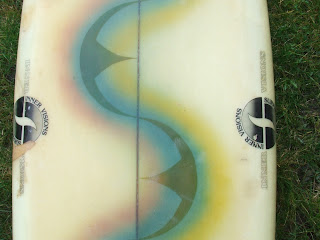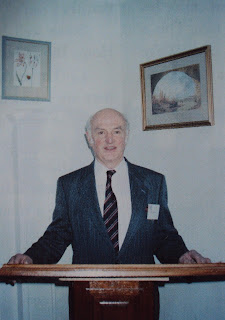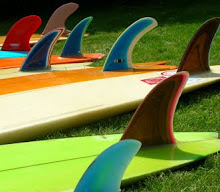Above - Fred Bickers
This is one of the best (or maybe only ?) articles about Bickers, straight from the horses mouth, written by John Conway in 1998 for his Malibu magazine. Since this mag is pretty obscure, I've been meaning to put the article on the blog - so here it is. I wish I'd hired a typist ..
John Conway tells the story of one of the pioneers who made boards in Newquay in the mid 60s. Earlier this year (1998) Ernest Frederick Bickers passed away. Fred, as he was known, has never had his rightful place in the history of British surfing. He was there at the start virtually. Whilst all the hype and noise was around Bilbo, Fred and Brian Schofield got on with the mysteries of blowing foam. The story started in 1964. Fred owned the Fernhill cabinet works that stood on the Whim in Newquay - Somerfield now stands on the land. The cabinet works was an old slaughter house that Fred turned into a joinery works and DIY shop.
Malibus were not the first surfboards Fred made. For a number of years he turned out small plywood ''chicken runs''(bellyboards). These were strips of marine plywood with a curved end that tourist by the thousand would ride on the whitewater around the Cornish coastline. It was the arrival of Brian Schofield at Fernhill that triggered Fred's interest in the 'new' Malibu boards. The first Malibu that came out of the joinery works was in fact a scaled version of an Australian board made from plywood and wooden internal formers. It was full of air. I remember it well, Brian Schofield and I took it down to Watergate at low tide to have what was to be our first surf ; the board sank. At the age of 16 I was too impatient to wait for Fred and Brian to get it right so I bought a second hand balsa board and through that summer learnt to surf.
In the winter of 1964 a secret project was going on in the loft above the paint shop at Fernhill. Strange smells would mingle with the aroma of sawn pine and mahogany. Fred and Brian were conducting foam blowing experiments. In the spring of 1965 Brian told me that Fred was going to open a surfboard factory in St Thomas' road and if I behaved I might even get a job there in the summer. This was a great privilege. Being an apprentice cabinet maker I was supposed to be learning a trade in joinery and cabinet manufacture, but not much of that went on in summer so I would be useful as a labourer in the board shop. The experimenting continued and after a few disappointments Fred and Brian got the foam blowing system to work. Laminating was a technique which was picked up easily and sanding and polishing were skills that both had, being tradesmen. Dave Friar came to work with Brian - he had worked over at Bilbo and brought with him valuable knowledge.

Above - this board was made for me in the summer of '65. It was considered unthinkable to have more than one trade decal on the boards, especially when the Bickers decals had gold leaf around the edge. The board weighed a tad under 30 lbs, was 9'6 long and as far as I can remember was fairly bombproof. There are no kneepaddling dents in the deck because it had one layer of 10 oz and a layer of 12 oz fibreglass on top of that. It is now owned by Andy Pickles and is part of his collection at the Bowgie inn, Crantock.
The first boards that had the Bickers label were seen on the beaches of Newquay in early 1965. The learning curve was short and Fred's factory started to make a board a week. With all the experimenting done, Brian applied his skills as a French polisher to the finishing of the boards with mock wooden panels. Bickers boards became the Rolls Royces of the day.
Above - I remember this picture, the board was a custom order with nose and tail blocks and a starburst fin. The reason I was topless was I had turned up to work in a Bob Head surfboards t shirt and I was told to remove it for the picture. Being the youngest and the cheapest I think I got to hold up all the special boards that were photographed by Fred.
Through the summer of 1965 we made some good looking boards with wood nose and tail blocks, coloured panels, designs that were faithfully scaled from the adverts in Surfer magazine. In the winter of '65 we all went back to Fernhill and cabinet making and joinery. I couldn't wait till the spring of 1966 and the opening of the surfboard factory. In that year Fred employed an Australian shaper called Mick Jackman. He had some fairly radical ideas about board shapes and colour design. That summer we got it together and Bickers boards were ridden by notable surfers of the day like 'Cribbar king' Jack Lydgate, Viv Wilson and his younger brother Robin, and a bunch of other up and coming surfers.

Above - This is a shot taken on the island on Towan beach, Newquay. Left to right : Dave Friar ( Dave along with Alan MacBride and Mick Stanley-Jones, 'Mobby' ,'Chin', Trevor Roberts and Richard Trewell represented the hardcore group of the day that Chris Jones, Roger Mansfield, Viv and Robin Wilson and myself used to emulate both on and off the board ). John Conway : this board was considered to be radical for its day. It was only 9ft and was a nose rider model. The good thing about it was it weighed in a under 25 lbs. Brian Schofield : Brian , father of TV celeb Philip was the driving force behind the production of Bickers boards. His skill as a french polisher took the finish to a very high level. Unidentified : I think his name was Bob Scott. Anyway the board he is holding is a standard board without any add ons such as nose and tail blocks, redwood stringers and a laminated wooden fin. photo Fred Bickers.
The locals were starting to get bitten by the surfing bug and boards seemed to be going everywhere. Mick Jackman also owned the Maui surf shop in the Blue Lagoon building. He hired out Bickers boards and sold them. I was put in charge of the sanding room, sanding down the boards prior to pin lining and glossing .Then they came back to me for polishing. Brian had worked out a polishing system which rendered the final finish like glass. Bickers finishes were the boards' trademark. Brian taught me to pin line boards and do panels whilst Mick Jackman showed me how to shape and do psychedelic resin designs. By mid summer of that year I was laminating as well under Brian's watchful eye.
Above - Dave Friar. This is the first board Bickers made. Dave rode it whilst he worked for Fred. The wetsuit is a bog standard diving variety that we all wore because Dennis Cross hadn't yet arrived on the scene with his Gul products.
Fred was always the boss. In those days apprentices would simply fade into the background when the boss was around. All except for the legendary day in 1966 when the Cribbar was ridden. I had been sent down to Fernhill for some nose and tail block material. I had snuck off via Newquay Harbour hill to watch the massive waves pounding the bay and if Fred caught me skipping off work normally I would have been in for it, but he stood by my side watching tose massive waves for a few minutes before suggesting that he was paying my wages and that I should get back to work.
Above - Brian Schofield. This was Brian's passion, polishing boards until you could adjust your Elvis haircut in the reflection.
In early 1967 Fred, with reasons known only to himself, decided to close down the surfboard factory. Brian Schofield went to Bilbo and Fred asked me to work up what materials were left into hire boards. This gave me the opportunity to do the whole thing myself - shaping through to finishing. Also , there were some Clark foam blanks that had been imported from America. These were to be made up first. I started with a board for myself. I finished it and Fred had a customer for it straight away so I made another one and that one sold. In the end I didn't get a clark foam board. I had the last blank that was left, too thin to make a custom board from. I ended up with a 8'11 x 20 x 2 1/2 board that looked dreadful but surfed like a demon.
Above - Some boards were real peaches, I wonder where this one is today.
I got to keep the Bob Head t shirt on for this shot. A noserider alongside a conventional model.
Fred Bickers provided an alternative surfboard to Bilbo in Newquay. Bickers boards were quality items and those that are still around today stand testimony to that quality. Also, without Fred Bickers I would not have been able to become a carpenter and joiner, get my City and Guilds as a cabinet maker and, more importantly, become a surfer and surfboard builder.
For you surfboard collectors out there consider this, Bilbo were manufacturing 20 boards a week and Bickers at the most made only three. So if you are offered a Bickers snap it up especially one with a Clark foam sticker on it, there were only ten of these boards ever made. A board in 1965 cost about £25 - £30 and considering my wage for a 48 hr week was £4.85, it was a princely sum. The conclusion I have drawn is that I should have hung on to all my old boards. As a footnote to this story, the St Thomas road factory after Fred disposed of it went on to manufacture Conway skateboards, John Conway surfboards, Eagle surfboards, Atlantic Surfer magazine and eventually became my photographic studio before being disposed of to get an unsympathetic high street bank off my back.
Where are they now ??
Brian Schofield worked at Bilbo before emigrating to New Zealand.
Dave Friar emigrated to Wales and opened a surf shop and became a Gower legend.
John Conway made his own boards and had a hand in opening Ocean Magic, Vitamin Sea, retired from surfboard making to work on Atlantic Surfer, Surf Scene and establish Wavelength magazine. (The longest running British surf mag ,from 1981 to present day)
Fred's wife Yvonne Bickers, at last year's surf meet in Newquay.
Very rare Bickers order form from September 1965

























.jpg)









































